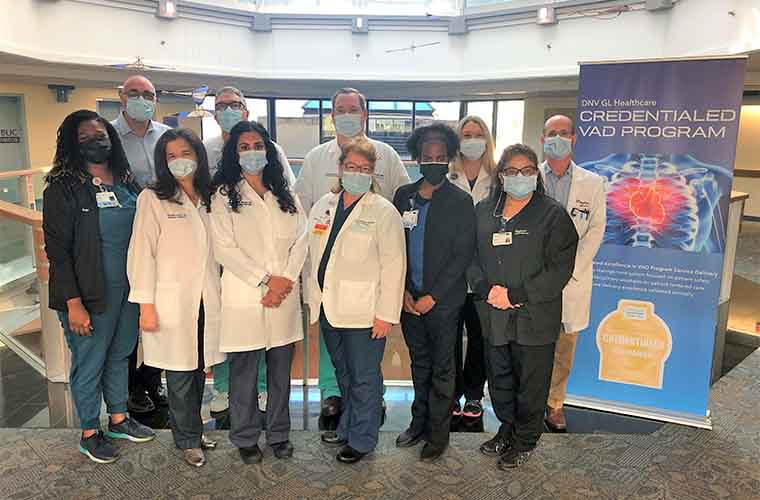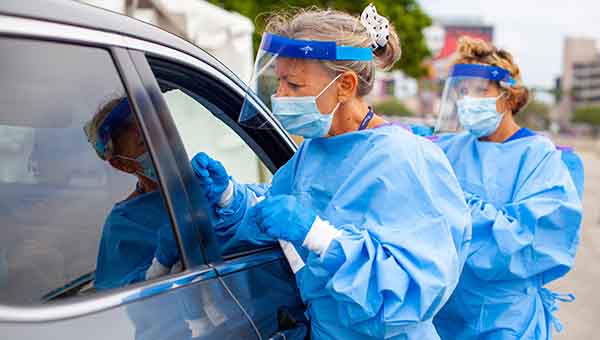Left Ventricular Assist Device Keeps Failing Hearts Pumping

After getting several stents, Richard Wheeler said he had a difficult time when his cardiologist at BayCare’s Mease Countryside Hospital told him there was nothing else he could do for him. Wheeler became one of the more than 6million people in the United States with heart failure, a condition where the heart cannot pump enough blood and oxygen to support other organs in the body. People with heart failure experience a variety of symptoms, and the condition impacts not only a person’s quality of life but can also be life threatening.
Heart failure can’t be cured, but it can be managed with the help of cardiac specialists and life-changing advanced technology. Though Wheeler’s cardiologist may not have been able to offer additional help, he didn’t leave Wheeler without options. He gave Wheeler a referral to BayCare’s Advanced Heart Failure-Mechanical Circulatory Support Program.
Since its inception in 2017, the BayCare program on campus at St. Joseph’s Hospital in Tampa has provided late- or end-stage heart failure patients with additional treatment options, such as partnering with a transplant center to offer a comprehensive range of inpatient and outpatient advanced heart failure services.
One of the services offered is the Left Ventricular Assist Device or the LVAD, which is what Wheeler needed. The LVAD is a mechanical pump that is implanted in patients with end-stage heart failure. It doesn’t replace the heart, but it helps the bottom left side of the heart, which is the left ventricle, pump blood out of the ventricle to the aorta and the rest of the body.
Implanting an LVAD or mechanical pump requires open heart surgery. The patient is put under general anesthesia, and a surgeon places the pump unit into the apex of the heart where it receives blood. A tube delivers the blood from the device to the aorta, which takes the blood to the rest of the body.
The LVAD is connected to the battery-operated controller through a cable that runs outside the patient’s body. The controller runs the pump and provides messages and alarms for the patient. At night, the patient recharges the batteries and sleeps while the LVAD is powered by a mobile power unit plugged into an electrical outlet. The surgery generally lasts four to six hours.
LVAD: A Permanent Solution for Richard Wheeler
The device is used for patients awaiting heart transplants and for those who are not transplant candidates, like Wheeler.
“After getting the information from my cardiologist, my wife and I made an appointment at BayCare’s Advanced Heart Failure-Mechanical Circulatory Program to find out more about the device and the surgery,” Wheeler said. “They didn’t promise anything, but I took it for what it was and hoped for the best.”
Wheeler had his surgery May 7, 2019, and it has helped him continue to enjoy life. “Before having the LVAD implanted, I was winded all the time. My physical activity was limited,” said Wheeler. “My quality of life is 10 times better than it was before I received the LVAD.”
“It means so much to me to have him physically better,” said Stella Wheeler, who has been married to Richard for 44 years. “He has gone through so much and always had the best attitude. He never gave up and never complained.”
LVAD: A Bridge to Transplant for Wayne Watkins
Other patients like Wayne Watkins need an LVAD as a bridge to transplant. As Watkins was waiting for a new heart, his doctor told him he had only about 30 days left to live without the LVAD implant.
“I said, ‘What are we waiting for?’,” Watkins recounts.
Watkins also was a patient at BayCare’s Advanced Heart Failure-Mechanical Circulatory Support Program when he received his LVAD.
“It kept me alive until a heart was available 20 months later,” said Watkins. That heart became available on New Year’s Eve 2020, and on Jan. 1, 2021, Watkins had a new heart.
During the months he had waited for the heart, Watkins had worked on getting in better shape. He went to cardiac rehabilitation at St. Joseph’s Hospital where he was closely monitored while doing assigned exercises, and he lost weight with the help of a dietitian at St. Joseph’s.
On Jan. 1, 2022, Watkins celebrated a year with his new heart. He is grateful every day for the LVAD device and the opportunity he had through BayCare’s program to have this done. “If anyone needs this, I will tell them to have the surgery,” Watkins said, “LVAD saved my life.”
BayCare’s Advanced Heart Failure-Mechanical Circulatory Support Program
BayCare’s Advanced Heart Failure-Mechanical Circulatory Support Program has helped many patients since successfully implanting the first LVAD in May 2019. In addition to this program, BayCare also provides a variety of other cardiovascular services for heart failure patients including five heart function clinics designed to quickly deliver care through a multidisciplinary care model to keep heart failure patients out of the hospital.
BayCare’s Advanced Heart Failure-Mechanical Circulatory Support Program is led by cardiologists Meenakshi Bhalla, MD, and Daniel Dries, MD, and cardiothoracic surgeon Michael Bradner, MD, For more information on the program, call (813) 397-1251 or email vadteam@baycare.org.


